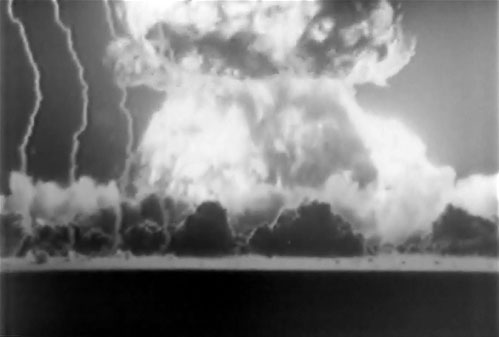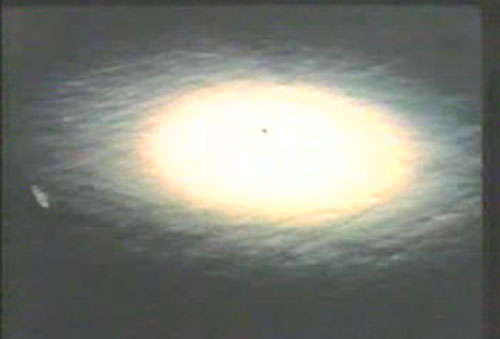Most films of nuclear explosions are dubbed. If they do contain an actual audio recording of the test blast itself (something I’m often suspicious of — I suspect many were filmed silently and have a stock blast sound effect), it’s almost always shifted in time so that the explosion and the sound of the blast wave are simultaneous.
This is, of course, quite false: the speed of light is much faster than the speed of sound, and the cameras are kept a very healthy distance from the test itself, so in reality the blast wave comes half a minute or so after the explosion. Basic physics that even a non-technical guy like me can understand.
It’s rare to find footage where the sound has not been monkeyed with in post-processing. So I was pleased when a Russian correspondent sent me a link to footage digitized by the National Archives of a 1953 nuclear test. The footage is very raw: it hasn’t been edited much, and is a bit washed out, but the audio is still in “correct,” original sync.

Click the image to go to a YouTube edit of the video that I made. You can see the original via NARA’s page, or click here for a direct link to the WMV file (90MB).
The video starts off pretty dark and muddled, but don’t let that turn you off. What’s interesting about this clip is not the visual aspects. The test looks like any old nuclear test, but with poor film quality.
The audio is what makes this great. Put on some headphones and listen to it all the way through — it’s much more intimate than any other test film I’ve seen. You get a much better sense of what these things must have been like, on the ground, as an observer, than from your standard montage of blasts. Murmurs in anticipation; the slow countdown over a megaphone; the reaction at the flash of the bomb; and finally — a sharp bang, followed by a long, thundering growl. That’s the sound of the bomb.1
The test itself was the ANNIE shot of Operation Upshot-Knothole, March 17, 1953. Carey Sublette reports that:
In an effort to calm public fears about weapons testing, Annie was an “open shot” – civilian reporters were permitted to view it from News Nob, 11 kilometers south of the shot-tower. Annie was a weapon development test, it was an experimental device (code named XR3) that provided additional information to normalize the yield-vs-initiation time curve. It was a Mk-5 HE assembly using a Type D pit, and used a betatron for external initiation (the third such test). Total device weight was 2700 lb, predicted yield was 15-20 kt.
There were U.S. troops there as well, as part of Operation Desert Rock V. They provide a huge amount of ambient noise. Whistles, “WHOAS!”, and “JEEZ!” follow the blast wave’s arrival.
Obviously watching a grainy black and white video on YouTube is not really going to give you that elusive sense of scale. But with a good pair of headphones, you really do get immersed in it — good audio triggers something special in the brain, above and beyond what you might expect it to do. So give it a shot, and cozy up to the real sounds of the bomb.
At the complete other end of the spectrum, there are films that the DOE has produced a number of silent nuclear test explosions… which someone thought would sound better with extremely cheesy synthesizer music behind it.

Click the image to access the MPEG file, or click here to view its entry at the DOE Nevada Site Office website.
Seriously. Wait for the “lasers.” In my experience, this is what a lot of promotional videos produced by the military look like, but I don’t know who is responsible for this particular atrocity. If you haven’t gotten enough with that one, here’s another.
Personally, I think silence is preferable to… that. The original, silent footage of the preparations for the Trinity test is much more haunting, in its way, than the many versions which add music or narration. But nothing really compares to the actual sound from the actual time — unedited.
- Robert Serber, on the sound of the Trinity test: “Some time later, the noise of the explosion reached us. It had the quality of distant thunder, but was louder. The sound, due to reflections from nearby hills, returned and repeated and reverberated for several seconds, very much like thunder.” [↩]



I quite like the little underwhelming “click” sound of the initial blast in this KTLA broadcast.
[…] the link to Alex Wellerstein’s blog. Share this:TwitterFacebookLike this:LikeBe the first to like this. Categories: Uncategorized […]
For my money, one of the most interesting videos of a shot has to be the one of the air-to-air 2Kt shot done in 1957 (the only unnamed shot in the history of testing, apparently) where several men are actually standing at ground zero and recording their reactions live. It’s amazing.
That’s pretty neat! Thanks for sharing it.
I’ve seen a brief clip of that before without the sound, but this version is remarkable. That’s shot John from Operation PLUMBBOB. Although the introductory text to the video says it went off at 10,000 feet, NRDC’s chronology of US nuclear tests (http://docs.nrdc.org/nuclear/files/nuc_02019401a_121.pdf) says it was actually 18,500 feet.
This was a test of the Genie air-to-air rocket and its W25 warhead. The rocket, fired by an F89J, traveled 4,240 meters in 4.5 seconds before detonating.
For what it’s worth, we manufactured 10,171 Genies, which were operational from 1957-84. Total cost was about $1 billion in today’s dollars (excluding the cost of the nuclear warhead). Approximately half (5,000) were nuclear-armed. The Genie was in large measure a response to the 1955 bomber gap (as was almost everything else we poured into continental air defense from the mid-1950s to the mid-1960s). All told, 11,000 warheads, nearly sixteen percent of all nuclear warheads we ever produced (and thirty-four percent of all operational weapons in 1965) were intended to counter and defeat what was at best a marginal Soviet airborne threat.
The Air Force cooked up the scenario of the officers standing beneath ground zero to demonstrate how safe it was to defend ourselves with the same fallout-generating type of weapons the Russians wanted to use on us — just as the fallout debate was starting to heat up.
The officers present were all volunteers. The fellow who was the photographer, a Japanese-American, was on _assignment_, working for the Lookout Mountain Laboratory.
My father was enlisted U.S. Army and was there and watched. They did not volunteer, unless enlisting was called that. They were given no protective gear. He said, that buildings and bridges were built, etc. to see what impact the explosions would have. He is 83 years old and still alive today.
[…] Source : Nuclear Weapon Archive Special Thanks To : Nuclear Secrecy […]
[…] But Alex Wellerstein, an historian of science at the American Institute of Physics, has shared a unigue video of a blast during America’s testing of nukes in the Yukka Mountain area of Nevada during the 1950s. […]
[…] Odds are that not many folks out there have seen a nuclear explosion up close. And it turns out that most of the films we’ve seen are dubbed or contain stock blast sound effects, a point I wasn’t aware of before coming across a blog curated by Alex Wellerstein, an historian of science at the American Institute of Physics.
[…]
[…] The U.S. National Archives has digitized footage of an atomic blast which took place at Yucca Flat, Nev., on March 17, 1953. The footage has just been uncovered by science historians, including Alex Wellerstein of the American Institute of Physics. […]
[…] But that’s not what it’s like if you are actually there. Science historian Alex Wellerstein has found an undoctored and deeply frightening recording – which he just posted on Restricted Data; the Nuclear Secrecy Blog. […]
[…] blog on nuclear secrecy and has posted a video of a nuclear test, together with its original sound here. You have to stick with it for both image and sound as the latter is delayed in line with the […]
[…] Via: Nuclear Secrecy blog […]
[…] Um adendo rápido: o outro lado também muitíssimo interessante do vídeo é ver (mediadamente) como acontece uma explosão atômica. O silêncio inicial, o flash de luz, e então – no que parece um tempo interminável – o barulho da explosão. Quem tem curiosidade sobre essa parte da experiência pode acompanhar uma discussão mais dealhada no “Restricted Data: The Nuclear Secrecy Blog“, nesse post aqui: “The Sound of the Bomb (1953)“. […]
[…] The Sound of the Bomb (7/13/2012) – 11,800 pageviews […]
[…] “The audio is what makes this great. Put on some headphones and listen to it all the way through — it’s much more intimate than any other test film I’ve seen. You get a much better sense of what these things must have been like, on the ground, as an observer, than from your standard montage of blasts. Murmurs in anticipation; the slow countdown over a megaphone; the reaction at the flash of the bomb; and finally — a sharp bang, followed by a long, thundering growl. That’s the sound of the bomb.” ~ Alex Wellerstein, The Sound of the Bomb (1953) […]
Alex, the reason that the video was so washed out on the “Annie” shot is because the video was made with a studio TV camera, which used “orthicon” tube technology. They had very limited dynamic lighting range (everything was too light or too dark, usually the latter); they were designed exclusively for studio use where the lighting could be closely controlled. Interestingly, that’s why the sound is pristine. The state of the art in the 50s was sound recording by optical track (there’s a delightful sidebar on that in Disney’s “Fantasia”), and it took a truckload of equipment. In this case, the video and audio were transmitted (by microwave, I assume) to a TV studio control room where both were recorded on the extremely expensive new wide reel magnetic tape drives. Sound on films was pretty much universally (excepting Hollywood-class movies) added in post-processing (excepting filming in a fixed studio) because of the impossible logistics involved in recording in the field.
So interesting. I’m wondering — would the cameras have been placed 11 km away along with the press on News Knob? Or were they closer than the observers? That is, how much silence would the civilian observers have experienced?
It is strange that even the footage of the open shots, meant to acquaint the public with the realities of nuclear weapons, were actually dramatized Hollywood style. I’m thinking here of the TV coverage of Operation Cue, which fills in the silence with music –https://www.youtube.com/watch?v=zU9lCKDzKSY
Seems to defeat the purpose of the open shot.